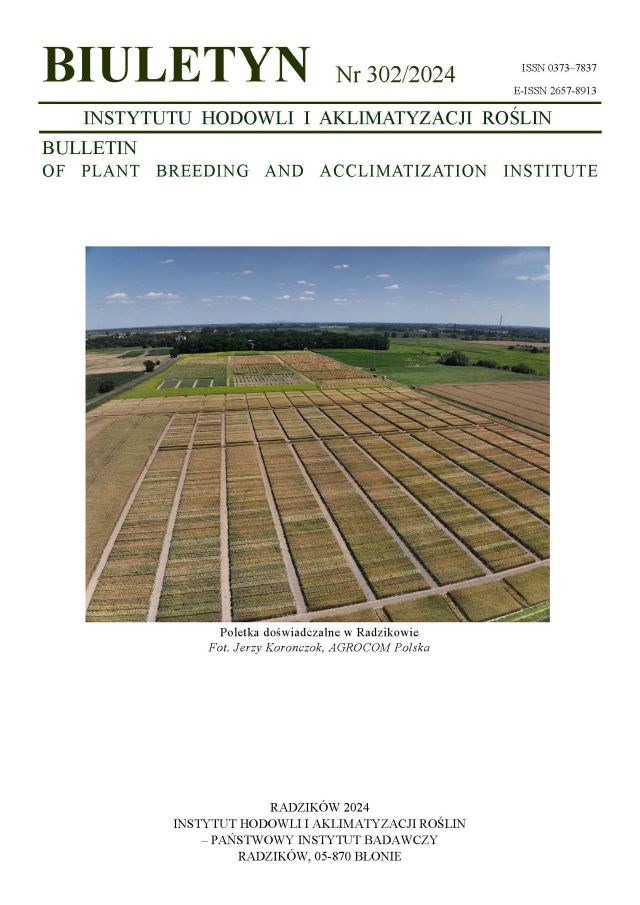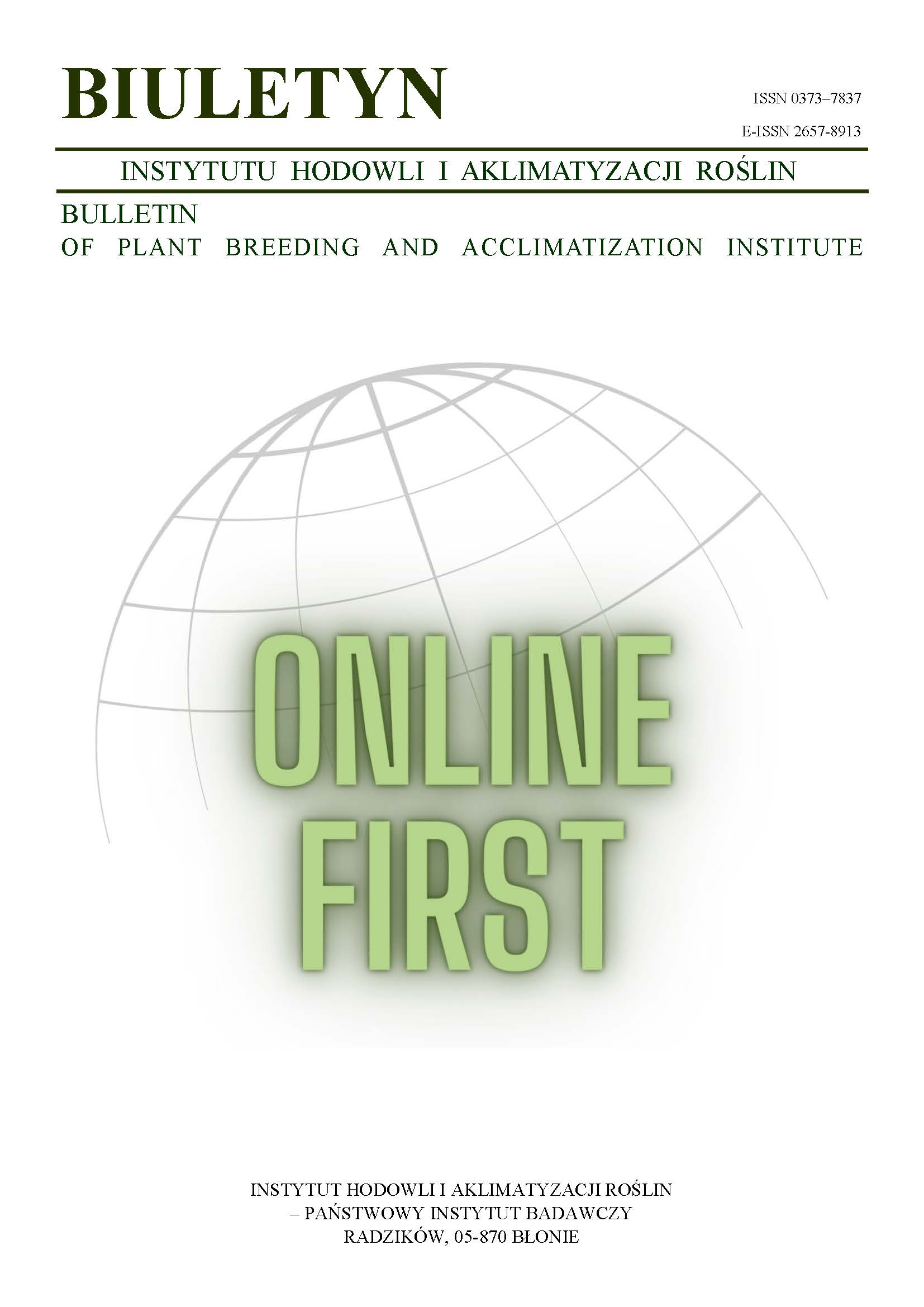Podstawy teoretyczne znaczenia efektów genotypowych i interakcyjnych w hodowli roślin na przykładzie pszenicy ozimej
Wiesław Mądry
wieslaw_madry@sggw.edu.plKatedra Biometrii SGGW, Warszawa (Poland)
Mike Talbot
Biomathematics and Statistics Scotland, Edinburgh (United Kingdom)
Krzysztof Ukalski
Katedra Biometrii SGGW, Warszawa (Poland)
Tadeusz Drzazga
Hodowla Roślin Rolniczych „Nasiona Kobierzyc” w Kobierzycach (Poland)
Marzena Iwańska
Katedra Biometrii SGGW, Warszawa (Poland)
Abstrakt
W pracy przedstawiono podstawowe problemy teoretyczne i wyniki badań eksperymentalnych w zakresie znaczenia i wykorzystania efektów genotypowych i interakcji genotypowo-środowiskowych oraz interakcji środowiskowej (miejscowości × lata) dla danej cechy ilościowej w programie hodowlanym i rejestracji odmian roślin uprawnych. Znaczenie tych efektów można określić za pomocą ocen ich wariancji (komponentów wariancyjnych), na podstawie wyników z reprezentatywnej wielokrotnej i wieloletniej serii doświadczeń z genotypami. Rozważania teoretyczne uzupełniono wynikami własnych i innych badań eksperymentalnych nad oceną komponentów wariancyjnych wspomnianych efektów dla plonu ziarna pszenicy ozimej, jako najważniejszej rośliny uprawnej. Stwierdzono, że w różnych rejonach świata i pulach genowych wariancja efektów interakcji miejscowości × lata ma największy udział w zmienności plonu ziarna pszenicy ozimej. Natomiast efekty interakcji genotypy × miejscowości × lata mają największe znaczenie wśród wszystkich efektów interakcji genotypowo-środowiskowych. Te dwa rodzaje efektów interakcyjnych ograniczają powtarzalność interakcji genotypy × miejscowości w różnych latach, decydującej z kolei o powtarzalności, w różnych latach, stabilności i adaptacji genotypów w rejonie rolniczym. Efekty interakcji genotypy × miejscowości są zwykle mniej zmienne, niż efekty genotypowe i efekty interakcji genotypy × lata. Uzyskane oceny komponentów wariancyjnych wymienionych efektów dla plonu ziarna pszenicy ozimej w badaniach własnych wykorzystano do zobrazowania symulacji najważniejszych charakterystyk, określających dokładność średnich fenotypowych genotypów dla rodów hodowlanych w docelowym rejonie uprawowym, zależnie od miejscowości, lat i liczby powtórzeń w serii doświadczeń.
Słowa kluczowe:
dane niekompletne, interakcja genotypowo-środowiskowa, komponenty wariancyjne, metoda REML, plon ziarna, pszenica ozima, szeroka i wąska adaptacjaBibliografia
Annicchiarico P. 1997. Joint regression vs AMMI analysis of genotype-environment interactions for cereals in Italy. Euphytica 94: 53 — 62.
DOI: https://doi.org/10.1023/A:1002954824178
Google Scholar
Annicchiarico P. 2002. Genotype × Environment Interactions — Challenges and Opportunities for Plant Breeding and Cultivar Recommendations. FAO, Rome. Plant Production and Protection Paper — 174.
Google Scholar
Annicchiarico P., Bellah F., Chiari T. 2006a. Repeatable genotype-location interaction and its exploitation by conventional and GIS-based cultivar recommendation on for durum wheat in Algeria. Eur. J. Agron. 24: 70 — 81.
DOI: https://doi.org/10.1016/j.eja.2005.05.003
Google Scholar
Annicchiarico P., Perenzin M. 1994. Adaptation patterns and definition of macro-environments for selection and recommendation of common wheat genotypes in Italy. Plant Breeding 113: 197 — 205.
DOI: https://doi.org/10.1111/j.1439-0523.1994.tb00723.x
Google Scholar
Annicchiarico P., Russi L. Piano E., Veronesi F. 2006 b. Cultivar adaptation across Italian locations in four turfgrass species. Crop Sci. 46: 264 — 272.
DOI: https://doi.org/10.2135/cropsci2005.0047
Google Scholar
Atlin G. N., McRae K. B., Lu X. 2000 a. Genotype × region interaction for two-row barley yield in Canada. Crop Sci. 40: 1 — 6.
DOI: https://doi.org/10.2135/cropsci2000.4011
Google Scholar
Atlin G. N., Baker R. J., McRae K. B., Lu X. 2000 b. Selection response in subdivided target regions. Crop Sci. 40: 7 — 13.
DOI: https://doi.org/10.2135/cropsci2000.4017
Google Scholar
Atlin G. N., McRae K. B. 1994. Resource allocation in Maritime cereal cultivar trials. Can. J. Plant Sci. 74: 501 — 505.
DOI: https://doi.org/10.4141/cjps94-091
Google Scholar
Baenziger P. S., Clements R. L., McIntosh M. S., Yamazaki W. T., Starling T. M., Sammons D. J., Johnson J. W. 1985. Effects of cultivar, environment and their interaction and stability analyses on milling and baking quality of soft red winter wheat. Crop Sci. 22: 5 — 8.
DOI: https://doi.org/10.2135/cropsci1985.0011183X002500010002x
Google Scholar
Baker R. J. 2002. Genotype-environment interaction. http://homepage.usask.ca/~rjb609/gxe.html.
Google Scholar
Basford H. E., Cooper M. 1998. Genotype × environment interactions and some considerations of their implications for wheat breeding in Australia. Aust. J. Agric. Res. 49: 153 — 174.
DOI: https://doi.org/10.1071/A97035
Google Scholar
Bernardo R. 2002. Breeding for quantitative traits in plants. Stemma Press, Woodbury, USA.
Google Scholar
Bramel-Cox P. J. 1996. Breeding for reliability of performance across unpredictable environments. In: M. S. Kang and H. G. Gauch (ed.) Genotype-by-environment interactionCRC Press, Boca Raton, FL: 309 — 339.
DOI: https://doi.org/10.1201/9781420049374.ch11
Google Scholar
Brennan P. S., Byth D. E., Drake D. W., DeLacy I. H., Butler D. G. 1981. Determination of the location and number of test environments for a wheat cultivar evaluation program. Aust. J. Agric. Res. 32: 189 — 201.
DOI: https://doi.org/10.1071/AR9810189
Google Scholar
Butler D. G., Redden R. J., DeLacy I. H., Usher T. 2000. Analysis of line × environment interactions for yield in navy beans. 1. Components of variance. Austr. J. Agric. Res. 51: 597 — 605.
DOI: https://doi.org/10.1071/AR97135
Google Scholar
Caliński T., Czajka S., Kaczmarek Z. 1987 a. A model for the analysis of a series of experiments repeated at several places over a period of years. I. Theory. Biul. Oceny Odmian 17/18: 7 — 33.
Google Scholar
Caliński T., Czajka S., Kaczmarek Z. 1987 b. A model for the analysis of a series of experiments repeated at several places over a period of years. II. Example. Biul. Oceny Odmian 17/18: 35 — 71.
Google Scholar
Chapman S. C., Cooper M., Butler D. G., Henzell R. G. 2000. Genotype by environment interactions affecting grain sorghum. I. Characteristics that confound interpretation of hybrid yield . Austr. J. Agric. Res. 51: 197 — 208.
DOI: https://doi.org/10.1071/AR99020
Google Scholar
Chapman S. C., de la Vega A. J. 2002. Spatial and seasonal effects confounding interpretation of sunflower yields in Argentina. Field Crops Research 73: 107 — 120.
DOI: https://doi.org/10.1016/S0378-4290(01)00185-X
Google Scholar
Collaku A., Harrison S. A., Finney P. L., Van Sanford D. A. 2002. Clustering of environments of southern soft red winter wheat region for milling and baking quality attributes. Crop Sci. 42: 58 — 63.
DOI: https://doi.org/10.2135/cropsci2002.5800
Google Scholar
Cooper M. 1999. Concepts and strategies for plant adaptation research in rainfed lowland rice. Field Crops Research 64: 13 — 34.
DOI: https://doi.org/10.1016/S0378-4290(99)00048-9
Google Scholar
Cooper M., Woodruff D. R., Phillips I.G., Basford K. E., Gilmour A. R. 2001. Genotype-by-management interactions for grain yield and grain protein concentration of wheat. Field Crops Research 69: 47 — 67.
DOI: https://doi.org/10.1016/S0378-4290(00)00131-3
Google Scholar
Cullis B. R., Thomson F. M., Fisher J, A, Gilmour A. R. Thompson R. 1996. The analysis of the NSW wheat variety database. II. Variance component estimation. Theor. Appl. Genet. 92: 28 — 39.
DOI: https://doi.org/10.1007/BF00222948
Google Scholar
de la Vega A. J., Chapman S. C. 2006. Defining sunflower selection strategies for a highly heterogeneous target population of environments. Crop Sci. 46: 136 — 144.
DOI: https://doi.org/10.2135/cropsci2005.0170
Google Scholar
De Ron A. M., Casquero P. A., González A. M., Santalla M. 2004. Environmental and genotypic effects on pod characteristics related to common bean quality. J. Agron. Crop Sci. 190: 248 — 255.
DOI: https://doi.org/10.1111/j.1439-037X.2004.00098.x
Google Scholar
DeLacy I. H., Basford K. E., Cooper M., Bull J. K., McLaren C. G. 1996. Analysis of multi-environment trials a historical perspective. In: M. Cooper and G. L. Hammer (Ed.) Plant adaptation and crop improvement”. CAB Int., Wallingford, Oxon, UK: 39 — 124.
Google Scholar
Fehr W. R. 1987. Principles of cultivar development: Theory and technique. Vol. 1. MacMillan, New York.
Google Scholar
Feyerherm A. M., Paulsen G.M., Fritz A. K. 2004. A statistical method for summarizing results of cultivar performance trials. Agron. J. 96: 992 — 996.
DOI: https://doi.org/10.2134/agronj2004.0992
Google Scholar
GENSTAT. 2002. The guide to Genstat. Release 6.1. VSN International. Oxford, UK.
Google Scholar
Grausgruber H., Oberforster M., Werteker M., Ruckenbauer P., Vollmann J. 2000. Stability of quality traits in Austrian-grown winter wheats. Field Crops Research 66: 257 — 267.
DOI: https://doi.org/10.1016/S0378-4290(00)00079-4
Google Scholar
Gravois K. A., Bernhardt J. L. 2000. Heritability and genotype x environment interactions for discolored rice kernels. Crop Sci. 40: 314 — 318.
DOI: https://doi.org/10.2135/cropsci2000.402314x
Google Scholar
Grüneberg W. J., Abidin E., Ndolo P., Pereira C. A., Hermann M. 2004. Variance component estimations and allocation of resources for breeding sweet potato under East African conditions. Plant Breeding 123: 311 — 315.
DOI: https://doi.org/10.1111/j.1439-0523.2004.01000.x
Google Scholar
Haji H. M., Hunt L.A. 1999. Genotype environment interactions and underlying environmental factors for winter wheat in Ontario. Can. J. Plant Sci. 79: 497 — 505.
DOI: https://doi.org/10.4141/P98-075
Google Scholar
Hill J., Becker H. C., Tigerstedt P. M. A. 1998. Quantitative and ecological aspects of plant breeding. Chapmann and Hall, London.
DOI: https://doi.org/10.1007/978-94-011-5830-5
Google Scholar
Kang M.S. 2002. Genotype-environment interaction: Progress and prospects. In: M. S. Kang (Ed), Quantitative Genetics, Genomics and Plant Breeding, CAB International Wallingford, UK 221 — 243.
DOI: https://doi.org/10.1079/9780851996011.0221
Google Scholar
Leon J., Becker H. C. 1988. Repeatability of some statistical measures of phenotypic stability. Correlations between single - year results and multi-years results. Plant Breeding 100: 137 — 142.
DOI: https://doi.org/10.1111/j.1439-0523.1988.tb00228.x
Google Scholar
Lin C. S., Binns M. R. 1994. Concepts and methods for analyzing regional trial data for cultivar and location selection. Plant Breeding Reviews 12: 271 — 297.
DOI: https://doi.org/10.1002/9780470650493.ch10
Google Scholar
Mądry W., Drzazga T., Laudański Z., Rajfura A., Krajewski P., Sieczko L. 2003. Statystyczna analiza adaptacji genotypów pszenicy ozimej na podstawie mieszanych modeli genotypowo-środowiskowych. Fragmenta Agronomica 80: 10 — 31.
Google Scholar
Mądry W. 2004. Modele i metody statystyczne analizy interakcji genotypowo-środowiskowej, stabilności i adaptacji genotypów. Post. Nauk Roln. 2/308: 29 — 43.
Google Scholar
Mądry W., Kang M. S. 2005. Scheffé-Caliński and Shukla models: their interpretation and usefulness in stability and adaptation analyses. Journal of Crop Improvement, 14:325 — 369.
DOI: https://doi.org/10.1300/J411v14n01_13
Google Scholar
Magari R., Kang M. S. 1997. SAS-STABLE: stability analysis of balanced and unbalanced data. Agron. J. 89: 829 — 832.
DOI: https://doi.org/10.2134/agronj1997.00021962008900060013x
Google Scholar
Magari R., Kang M.S., Zhang Y. 1997. Genotype by environment interaction for ear moisture loss rate in corn. Crop Sci. 37: 774 — 779.
DOI: https://doi.org/10.2135/cropsci1997.0011183X003700030014xa
Google Scholar
Navabi A., Yang R. C., Helm J., Spaner D. M. 2006. Can spring wheat-growing megaenvironments in the Northern Great Plains be dissected for representative locations or niche-adapted genotypes? Crop Sci 46:1107 — 1116
DOI: https://doi.org/10.2135/cropsci2005.06-0159
Google Scholar
Patterson H. D., Silvey V., Talbot M., Wheatherup T. C. 1977. Variability of yields of cereal varieties in U.K. trials. J. Agric. Sci. Camb. 89: 239 — 245.
DOI: https://doi.org/10.1017/S002185960002743X
Google Scholar
Peterson C. J., Graybosch R. A., Shelton D. R., Baenziger P. S. 1998. Baking quality of hard winter wheat: Response of cultivars to environment in the Great Plains. Euphytica 100: 157 — 162.
DOI: https://doi.org/10.1023/A:1018361502435
Google Scholar
Primomo V. S., Falk D. E., Ablett G. R., Tanner J. W., Rajcan I. 2002. Genotype environment interactions, stability, and agronomic performance of soybean with altered fatty acid profiles. Crop Sci. 42: 37 — 44.
DOI: https://doi.org/10.2135/cropsci2002.3700
Google Scholar
Russell W. K., Eskridge K. M., Travnicek D. A., Guillen-Portal F. R. 2003. Clustering environments to minimize change in rank of cultivars. Crop Sci. 43: 858 — 864.
DOI: https://doi.org/10.2135/cropsci2003.8580
Google Scholar
Searle S. R. 1987. Linear models for unbalanced data. J. Wiley & Sons, New York.
Google Scholar
Searle S. R., Casella G., McCulloch C. E. 1992. Variance components. John Wiley & Sons, New York.
DOI: https://doi.org/10.1002/9780470316856
Google Scholar
Simmonds N.W., Smartt J. 1999. Principles of Crop Improvement. Blackwell Science, Oxford.
Google Scholar
Sudarić A., Šimic D., Vratarić M. 2006. Characterization of genotype by environment interactions in soybean breeding programmers of southeast Europe. Plant Breeding125: 191 — 194.
DOI: https://doi.org/10.1111/j.1439-0523.2006.01185.x
Google Scholar
Talbot M. 1984. Yield variability of crop varieties in the UK. 1984. J. Agric. Sci. 102: 315 — 321.
DOI: https://doi.org/10.1017/S0021859600042635
Google Scholar
Talbot M. 1997. Resource allocation for selection systems. In: “Kempton R. A., Fox P. N., (Ed). Statistical methods for plant variety evaluation”, Chapman and Hall, London: 162 — 174.
DOI: https://doi.org/10.1007/978-94-009-1503-9_10
Google Scholar
Troyer A. F. 1996. Breeding for widely adapted popular maize hybrids. Euphytica 92: 163 — 174.
DOI: https://doi.org/10.1007/BF00022842
Google Scholar
Weber W. E., Westermann T. 1994. Prediction of yield for specific locations in German winter-wheat trials. Plant Breeding 113: 99 — 105.
DOI: https://doi.org/10.1111/j.1439-0523.1994.tb00711.x
Google Scholar
Westcott B. 1987. Yield assessment. In: Lupton F. G. H. (Ed.) Wheat breeding its scientific basis. Chapman and Hall, London: 339 — 368.
DOI: https://doi.org/10.1007/978-94-009-3131-2_12
Google Scholar
Yan W. Kang M. S. 2003. GGE biplot analysis: a graphical tool for breeders, geneticists and agronomists. CRC Press, Boca Raton, FL.
DOI: https://doi.org/10.1201/9781420040371
Google Scholar
Yan W., Hunt L. A. 2001. Interpretation of genotype-environment interaction for winter wheat yield in Ontario. Crop Sci. 41: 19 — 25.
DOI: https://doi.org/10.2135/cropsci2001.41119x
Google Scholar
Yan W., Hunt L.A., Johnson P., Stewart G., Lu X. 2002. On-farm strip trials vs. replicated performance trials for cultivar evaluation. Crop Sci. 42: 385 — 392.
DOI: https://doi.org/10.2135/cropsci2002.3850
Google Scholar
Yan W., Hunt L.A., Sheng Q., Szlavnics Z. 2000. Cultivar evaluation and mega-environment investigation based on the GGE biplot. Crop Sci. 40: 597 — 605.
DOI: https://doi.org/10.2135/cropsci2000.403597x
Google Scholar
Yan W., Rajcan I. 2002. Biplot analysis of test sites and trait relations of soybean in Ontario. Crop Sci. 42: 11 — 20.
DOI: https://doi.org/10.2135/cropsci2002.1100
Google Scholar
Yan W., Rajcan I. 2003. Prediction of cultivar performance based on single versus multiple-year tests in soybean. Crop Sci. 43: 549 — 555.
DOI: https://doi.org/10.2135/cropsci2003.5490
Google Scholar
Yang R. C., Blade S. F., Crossa J., Stanton D., Bandara M. S. 2005. Identifying isoyield environments for field pea production. Crop Sci. 45: 106 — 113.
DOI: https://doi.org/10.2135/cropsci2005.0106a
Google Scholar
Autorzy
Mike TalbotBiomathematics and Statistics Scotland, Edinburgh United Kingdom
Autorzy
Krzysztof UkalskiKatedra Biometrii SGGW, Warszawa Poland
Autorzy
Tadeusz DrzazgaHodowla Roślin Rolniczych „Nasiona Kobierzyc” w Kobierzycach Poland
Autorzy
Marzena IwańskaKatedra Biometrii SGGW, Warszawa Poland
Statystyki
Abstract views: 29PDF downloads: 5
Licencja
Prawa autorskie (c) 2025 Wiesław Mądry, Mike Talbot, Krzysztof Ukalski, Tadeusz Drzazga, Marzena Iwańska

Utwór dostępny jest na licencji Creative Commons Uznanie autorstwa – Na tych samych warunkach 4.0 Miedzynarodowe.
Z chwilą przekazania artykułu, Autorzy udzielają Wydawcy niewyłącznej i nieodpłatnej licencji na korzystanie z artykułu przez czas nieokreślony na terytorium całego świata na następujących polach eksploatacji:
- Wytwarzanie i zwielokrotnianie określoną techniką egzemplarzy artykułu, w tym techniką drukarską oraz techniką cyfrową.
- Wprowadzanie do obrotu, użyczenie lub najem oryginału albo egzemplarzy artykułu.
- Publiczne wykonanie, wystawienie, wyświetlenie, odtworzenie oraz nadawanie i reemitowanie, a także publiczne udostępnianie artykułu w taki sposób, aby każdy mógł mieć do niego dostęp w miejscu i w czasie przez siebie wybranym.
- Włączenie artykułu w skład utworu zbiorowego.
- Wprowadzanie artykułu w postaci elektronicznej na platformy elektroniczne lub inne wprowadzanie artykułu w postaci elektronicznej do Internetu, lub innej sieci.
- Rozpowszechnianie artykułu w postaci elektronicznej w internecie lub innej sieci, w pracy zbiorowej jak również samodzielnie.
- Udostępnianie artykułu w wersji elektronicznej w taki sposób, by każdy mógł mieć do niego dostęp w miejscu i czasie przez siebie wybranym, w szczególności za pośrednictwem Internetu.
Autorzy poprzez przesłanie wniosku o publikację:
- Wyrażają zgodę na publikację artykułu w czasopiśmie,
- Wyrażają zgodę na nadanie publikacji DOI (Digital Object Identifier),
- Zobowiązują się do przestrzegania kodeksu etycznego wydawnictwa zgodnego z wytycznymi Komitetu do spraw Etyki Publikacyjnej COPE (ang. Committee on Publication Ethics), (http://ihar.edu.pl/biblioteka_i_wydawnictwa.php),
- Wyrażają zgodę na udostępniane artykułu w formie elektronicznej na mocy licencji CC BY-SA 4.0, w otwartym dostępie (open access),
- Wyrażają zgodę na wysyłanie metadanych artykułu do komercyjnych i niekomercyjnych baz danych indeksujących czasopisma.
Inne teksty tego samego autora
- Tomasz Góral, Halina Wiśniewska, Piotr Ochodzki, Dorota Walentyn-Góral, Iga Grzeszczak, Jolanta Belter, Maciej Majka, Jerzy Bogacki, Tadeusz Drzazga, Bogusława Ługowska, Przemysław Matysik, Edward Witkowski, Krzysztof Rubrycki, Urszula Woźna-Pawlak, Fuzarioza kłosów oraz akumulacja toksyn fuzaryjnych w ziarnie rodów hodowlanych pszenicy ozimej , Biuletyn Instytutu Hodowli i Aklimatyzacji Roślin: Nr 282 (2017): Wydanie regularne
- Maciej Majka, Magdalena Gawłowska, Adriana Twardawska, Marek Korbas, Jakub Danielewicz, Tomasz Góral, Bogusława Ługowska, Jolanta Belter, Edward Witkowski, Tadeusz Drzazga, Przemysław Matysik, Urszula Woźna-Pawlak, Halina Wiśniewska, Wykorzystanie markerów molekularnych i fenotypowych do identyfikacji genów odporności pszenicy na łamliwość źdźbła powodowaną przez Oculimacula yallundae i O. acuformis , Biuletyn Instytutu Hodowli i Aklimatyzacji Roślin: Nr 288 (2020): Wydanie regularne
- Joanna Ukalska, Krzysztof Ukalski, Tadeusz Śmiałowski, Wiesław Mądry, Badanie zmienności i współzależności cech użytkowych w kolekcji roboczej pszenicy ozimej (Triticum aestivum L.) za pomocą metod wielowymiarowych. Część II. Analiza składowych głównych na podstawie macierzy korelacji fenotypowych i genotypowych , Biuletyn Instytutu Hodowli i Aklimatyzacji Roślin: Nr 249 (2008): Wydanie regularne
- Dariusz Gozdowski, Wiesław Mądry, Zdzisław Wyszyński, Analiza korelacji i współczynników ścieżek w ocenie współzależności plonu ziarna i jego składowych u dwóch odmian jęczmienia jarego , Biuletyn Instytutu Hodowli i Aklimatyzacji Roślin: Nr 248 (2008): Wydanie regularne
- Wiesław Mądry, Dariusz Gozdowski, Historia rozwoju statystycznych metod planowania i analizy doświadczeń rolniczych na świecie oraz w Polsce , Biuletyn Instytutu Hodowli i Aklimatyzacji Roślin: Nr 288 (2020): Wydanie regularne
- Krzysztof Ukalski, Joanna Ukalska, Tadeusz Śmiałowski, Wiesław Mądry, Badanie zmienności i współzależności cech użytkowych w kolekcji roboczej pszenicy ozimej (Triticum aestivum L.) za pomocą metod wielowymiarowych. Część I. Korelacje fenotypowe i genotypowe , Biuletyn Instytutu Hodowli i Aklimatyzacji Roślin: Nr 249 (2008): Wydanie regularne
- Marcin Studnicki, Wiesław Mądry, Tadeusz Śmiałowski, Wielocechowa analiza różnorodności fenotypowej w kolekcji roboczej pszenicy jarej , Biuletyn Instytutu Hodowli i Aklimatyzacji Roślin: Nr 252 (2009): Wydanie regularne
- Anna Rajfura, Wiesław Mądry, Tadeusz Drzazga, Marzena Iwańska, Wydzielanie grup miejscowości na podstawie serii doświadczeń wielokrotnych ze zmiennym składem odmian w latach przy użyciu pakietu SEQRET. Część II. Przykład dla plonu ziarna z doświadczeń przedrejestrowych z pszenicą ozimą , Biuletyn Instytutu Hodowli i Aklimatyzacji Roślin: Nr 250 (2008): Wydanie regularne
- Adriana Derejko, Wiesław Mądry, Dariusz Gozdowski, Jan Rozbicki, Jan Golba, Mariusz Piechociński, Marcin Studnicki, Wpływ odmian, miejscowości i intensywności uprawy oraz ich interakcji na plon pszenicy ozimej w doświadczeniach PDO , Biuletyn Instytutu Hodowli i Aklimatyzacji Roślin: Nr 259 (2011): Wydanie regularne
- Dariusz Gozdowski, Wiesław Mądry, Charakterystyka i empiryczne porównanie prostej oraz złożonej analizy ścieżek w ocenie determinacji plonu roślin przez ich cechy plonotwórcze. Część I. Prezentacja stosowanych metod , Biuletyn Instytutu Hodowli i Aklimatyzacji Roślin: Nr 249 (2008): Wydanie regularne














